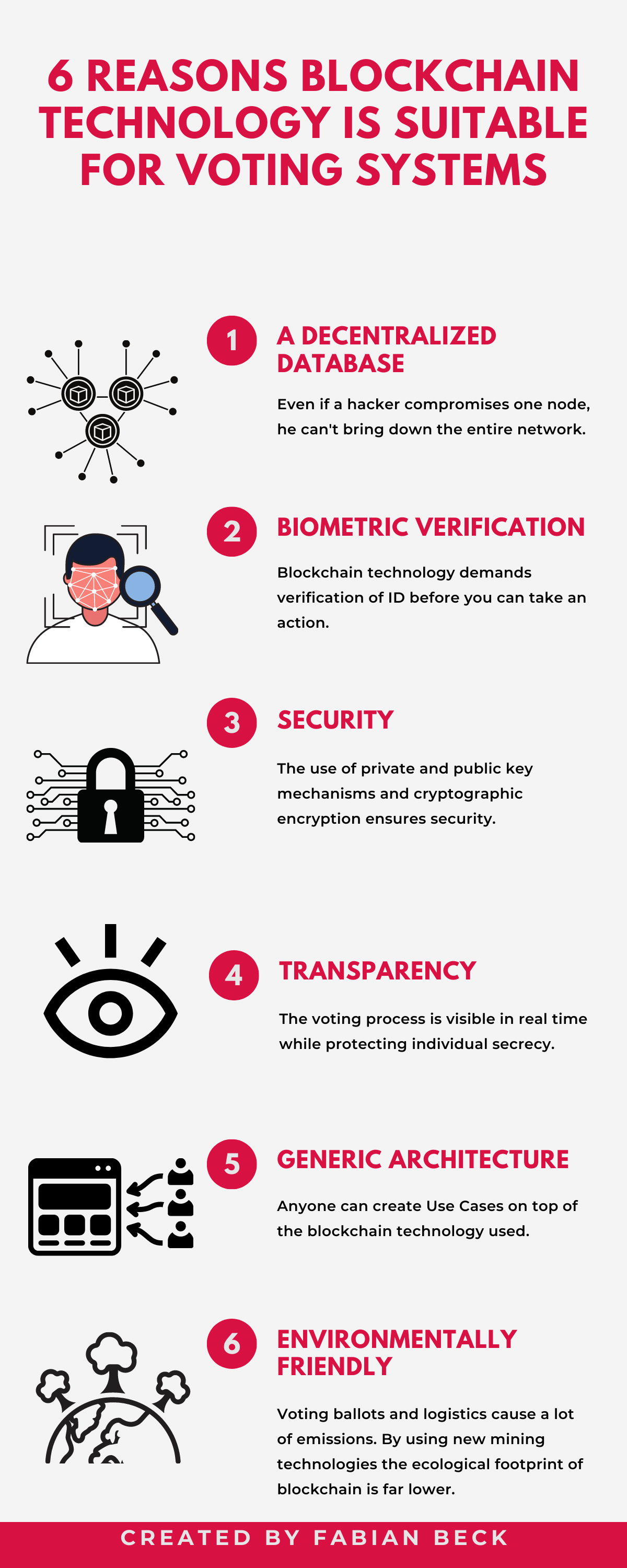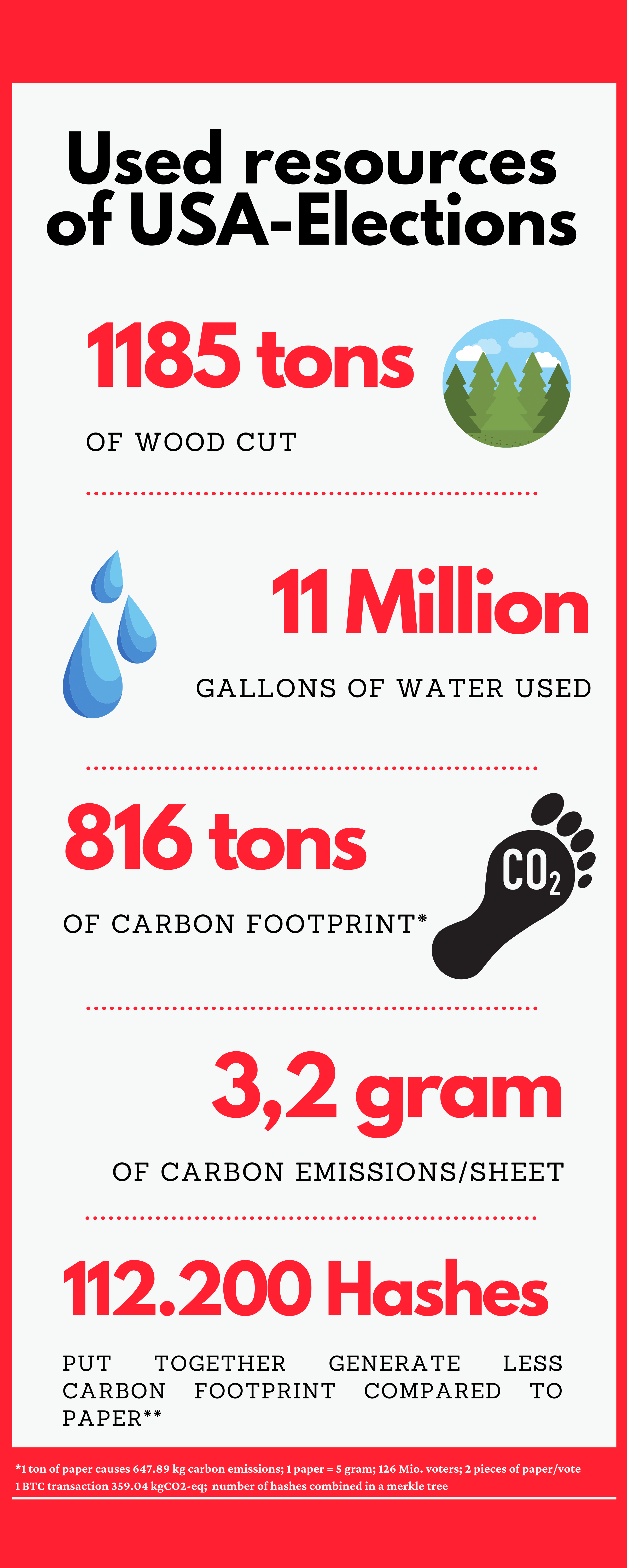How Blockchain Voting Systems Transform the Way We Vote
Salomon Kisters
May 18, 2021This post may contain affiliate links. If you use these links to buy something we may earn a commission. Thanks!
The US elections in 2016 and in 2020 should have shown that the demand for secure and not manipulatable voting processes has never been higher. In this article, we answer how this is achieved by using the advantages of blockchain technology.
We will answer the following questions:
- Why are current Voting Systems are insecure?
- Has there already been a Blockchain Based Vote?
- Why is Blockchain Technology suitable for Voting Systems?
- Which startups are already implementing usable Technologies?
- What are reasons against a Blockchain Based Voting System?
The need for transformation
Democracy has become a fun word for many nations. On one side, governments tell their public they have the power to “run” the country, and on the other hand, they have to stand hours in line to get their leaders elected. What’s worse is even after doing all this struggle, most of the nations still have doubts about vote manipulations.
It is worth noticing that voting systems exist at all levels. Let it be choosing the head boy or head girl of a school to electing the president – elections are everywhere. However, since the most sophisticated (relatively) voting systems are deployed at the national level, we can have a fair idea of what the rest of the country would face if the Tier-1 leadership cannot guarantee transparent voting to its public.
Why current Voting Systems are insecure
Imagine hackers can get into a voting system way before the event starts and keep rigging the entire process without letting anyone know.
For instance, to give you more idea, a hacker could get his hands on a database of voters in a constituency and wipe off a few thousand records. As a result, when these voters visit the polls, they won’t be able to vote for anyone as the system won’t be able to detect them.
Moreover, let’s talk about the national elections of any country. Thousands of electronic devices are involved in each event that runs on different types of software and an array of networks. With this versatility, they are pretty prone to hacking, and once they are exposed, no one can control them other than the hacker – who can do anything on these devices remotely. You should note pretty much all traditional voting systems are class-based, and if a single functionality gets broken on one machine, the fault will reflect on every device and system on the network.
It implies that if a single fault is exploited, thousands of systems could start malfunctioning immediately.
While we only discussed the problems related to national voting systems above, the same set of issues exist in other small-scale voting systems.
The Regulatory Environment
Hundreds of years ago, voting used to be very simple because the governments were not departmentalized, and everything used to be centrally controlled by a few prominent faces. However, in the current century, there is a department for every aspect of governance. This leads to a very complex scenario where, in order to devise a regulatory framework, several department heads have to sit together to coin a policy. After that, a robust yet automated system needs to ensure the compliance of voting events in the long run as well.
In most cases, voting systems, particularly the terminals, are expected to comply with a hefty set of regulatory statements, and it makes a very clumsy process. The situation gets even more challenging when we talk about national elections where each state must have its customized regulatory clauses. Apart from the fact that this is a tedious process from a management perspective, the provenance also gets affected. Therefore, a more practical way is to utilize the strengths of blockchain technology. To ensure that triggers can be set to ensure that, whenever a new set of regulatory requirements comes in from any department or state, they can easily be merged with the overall system without recoding the logic and halt the entire system. Furthermore, it would also enable the stakeholders to view the provenance of each decision, as to who overrode a clause, the reason, the timestamp, and the outcome as well.
Has there already been a Blockchain Based Vote?
The concept of decentralization has been around for decades; however, its most robust application happens to be in the form of blockchain technology. Despite that, after many years of the launch of Bitcoin, the masses still think that blockchain technology only has financial use cases.
However, as more people adopted it, mainly when Ethereum and other Enterprise-Grade blockchains surfaced the market, everyone realized the immense potential and the extent of the versatility offered by this technology.
In 2012 when a few Canadian scientists tried utilizing the inherent properties of the Bitcoin network to perform “carbon dating” in a digital environment and use it to trace the provenance of information - the aim was to strengthen or instead “fortify” the architecture of e-voting systems.
The first method derived by the two scientists in this regard was called CommitCoin. It allowed them to ensure everyone’s votes security and make it immutable for anyone after getting broadcasted.
Why is Blockchain Technology suitable for Voting Systems?
Blockchain technology consists of a single mutually agreed upon ledger of transactions shared by millions of nodes. To make any change to the existing data on the network, the hacker or any fraudster would need to have a consensus, which implies “forcing” 51% of the total nodes to default simultaneously. Since it is practically and computationally (almost) impossible to do, the probability of a record getting changed stands next to zero. This characteristic is probably the most celebrated property of this technology that makes it suitable for voting systems.

A Decentralized Database
There are centralized databases for storing voters’ credentials in traditional systems, and the counts of votes are also stored on such centralized models. Therefore they are prone to cybersecurity events. In case of an attack by a malicious adversary by one server collapsing, the entire system would collapse as well. However, as discussed above, blockchain-based systems are purely decentralized. Even if a hacker compromises one node, he would have to gain a majority to bring down the network.
Biometric Verification
One of the gravest concerns faced in pretty much all centralized architectures, voting in particular, is identity theft. Any digitally sound person could steal anyone’s ID record and vote on his behalf. Blockchain technology demands the ID of a user be verified before he can take action on the system to prevent the loss of a personal ID record.
For instance, if you register on a blockchain system that empowers the voting system of the United States, you first need to prove and validate that you are a US citizen.
Please note that while biometric verification is relatively swift in this regard. There are other methods, such as passcodes and OTPs, that modern applications frequently use.
It is also worth noticing that most blockchain-based systems now demand KYC checks for each individual who registers on the platform. The same concept can be applied to a voter as well, thus increasing the system’s overall security.
Security
Apart from the mainstream security practices followed by blockchain-based voting systems, it is essential to discuss the technology’s core benefits.
Elliptic Curve Cryptography is at the forefront of blockchain’s high-grade security. Suppose we understand it purely from the voting perspective. In that case, it implies that each voter gets to have two unique keys on the network that are created via mathematical formulas as soon as their accounts are created. While one of the associated keys is exposed to the public and can also be deemed as the voter’s identity on the network that is viewable by others as well, the private key stays hidden from everyone and is primarily used by the account owner only to verify his identity and perform an array of actions on the network, as and when needed.
The private key can also be regarded as his signature in the cryptographic sphere, and none of the outgoing transactions can be related to this user if the private key is not associated with it.
Since the user or any network administrator does not have to do it manually and the mathematical formulas take care of the entire process seamlessly, the probability of an external element hacking the whole process stands next to zero.
Transparency
Anything can be bribed or somewhat “motivated” to malfunction in the traditional world, let it be a machine or an individual. This potential issue renders them doubtful when most sensitive use cases, such as voting, are discussed.
With the help of blockchain’s provenance, we can always count the votes in real time and revert to an election result at a later date without having an ounce of doubt about its legitimacy.
It cannot be ignored that whenever an online survey was conducted to determine how many people would prefer online voting, masses always went to support this thought, and the logic was also quite reasonable – most of the people believe that when they can opt to use digital means for everything ranging from groceries to digital banking, there is no point why they would go against voting if the governments bring advancements in the digital structure around it. However, the masses always stress that they should have the confidence that their opinion, expressed via votes, would be respected, and it should always be transparent, despite the “level” of elections.
Therefore, if we read the previous section in conjunction with this demand, it is pretty clear that their demands can be met with the help of Elliptic Curve technology.
It should also be noted that with the combination of all these technologies, individual voters will be able to “peek inside” each ballot box and see whether the announced election results match with the counts in each ballot box or not.
In the past, it has been advocated several times that when a large-scale process becomes transparent, the secrecy of individuals is compromised, and this is just a bluff by authorities as they do not want to hand over the power to the masses. However, blockchain technology is different in this regard. With the help of ECC, it ensures that the optimum level of transparency is maintained, but each network member enjoys individual secrecy.
Generic Architeture
Voting is not only about selecting a President. It could be anything ranging from that to conducting a poll on the internet. Since each use case has its own set of requirements that could be quite different in nature and implementation, it is essential to treat them fairly at the code and architecture level. While the traditional systems that depend on centralized databases are pretty rigid, blockchain technology provides the perfect feasibility. It enables anyone on the internet to create any imaginable voting use case on top of it.
Environmentally Friendly

Despite being in the latest century, several countries go for paper balloting. Even the ones with other modern means utilize so much electricity that it has started causing severe environmental implications. We must try to curb it to save the planet and ensure the longevity of the voting process. To give you an idea of the elections held in the United States in 2012, here are the hot stats: Roughly 126M voters contributed to the “democratic process” At least one low-quality paper per person was used to cast the vote 1185 tons of wood were cut Approximately 11M gallons of water were used to make the paper 17,250M BTUs of energy were used The solid wasted was gauged to be about 981,800 pounds. Even after taking into account 50% of these ballots were recycled, the numbers are enormous to puncture the hole in Global efforts to protect the environment. The worse part is that we have entirely ignored more than 27,000 pounds of harmful gases released into the environment as a result of operating different kinds of machinery (e.g., cars used for commuting, etc.). To give you a hint, these pollutants, such as NO and SO, are two of the prime catalysts in destroying our environment. If you compare this entire activity at a mass scale in different countries and move it on a big blockchain canvas, all processes can get paperless. As a result, everything mentioned in the bullet points above can dissipate from the list, or at least the numbers decrease to a great extent. Due to the use of digital means, there won’t be any hassle to verify the voters, they wouldn’t even have to commute to the booth in some cases, thus saving emissions, and as mentioned before, none of the trees would have to be cut just to “cast a vote”. Above all, everything will become speedier!
However, the footprint of crypto mining should not be underestimated. For one Bitcoin transaction, according to financialexpress.com, 359.04kg of carbon emissions are emitted. Therefore emissions would be far higher compared to a paper vote. By combining a lot of electronic information in one transaction hash value, these emissions reduce drastically. By combining 112.200 Hash values of different voting documents in one Hash value, the carbon footprint is equaled. Thus, doubling or tripling this number cuts emissions to 50% and 33%, respectively.
Which startups are already implementing usable Technologies?
We have gathered some startups, that are all working in the Blockchain Space.
As of yet, we have a handful of startups working in the blockchain space to revolutionize voting. Before we start exploring these ventures, it is worth mentioning that some governments have also started using this technology to change their “exposed” voting mechanism. For instance, the Thai Democrat Party organized an election for its party leader in 2018 and they used the ZCoin network. This event was quite a major achievement for blockchain spheres as it happened to be the first occurrence or rather implementation of the blockchain technology at such a massive scale as the entire country contributed 127,479 votes via the new system.
Horizon State
They offer one of the best and most comprehensive solutions for governments, councils, corporations, political parties, publishers, creditor voting, bargaining agreements, and a lot more.
To provide the generic voting solution, they offer a digital ballot box that is not only highly encrypted but saves millions of dollars in the long run for organizations and nations. Every network member has the native tokens called HST, and each token represents their voting power. In some cases, developers can also attach weightage to each vote. For instance, if directors vote for an event, it would carry more weight than an ordinary user on the network – this is quite useful in companies where internal voting is required.
Because it’s entirely digital, the members can vote right from their mobiles or laptops and do not have to visit any physical location at all. Therefore they are saving a lot of hassle for the users and boosting participation as well.
Apart from mainstream voting, Horizon State also caters to the use case of a transparent feedback management system. For instance, if a call center deployed a feedback system at the end of the conversation and a customer gives a bad rating to an employee, the database administrator always has the liberty to override the rating and change it to whatever he wants. So, this solution comes in handy in such instances. It ensures that once feedback is recorded, it can never be changed or deleted by anyone.
As a result of these features, the voting or feedback event is impenetrable—furthermore, the reputation and reliability of any organization implementing it are elevated.
OriginStamp
While we primarily deal with protecting Intellectual Property from copyright infringement with the help of blockchain technology, our solution is quite generic and follows the SaaS architecture. Thus, making it one of the robust tools to be used in the voting industry. To understand its implementation, we will go for a unique use case (i.e., art gallery) in terms of voting, and there are two phases for doing so. Firstly, any person in the World who is the legitimate creator of an artwork (aka IP holder) would upload his work on the OriginStamp platform. The moment he does so, it would get timestamped. The entire network would know that this particular piece of art belongs to a specific person, and nobody can ever commit copyright infringement as they can always be proven wrong. Secondly, an art gallery could set up another platform where these artworks, published by their respective creators, are displayed. The public is asked to vote for each so the winner can be chosen and presented the reward. Since quality artworks are often sold for millions of dollars, the utility of blockchain technology in both phases would ensure that: Nobody can steal or change someone else’s work The provenance of voting can continuously be tracked even if decades have passed
FollowMyVote
Although they offer several use cases, the primary one is related to revolutionizing the voting system, as the name suggests.
One of the best perks about this venture is that it does not just reform the core voting practices. It redefines the end-to-end process. For instance, we have observed that in modern systems, the username and password are being replaced with other techniques because they do not only take more time but are less secure as well.
Therefore, instead of having a digital voting system that takes passwords, FollowMyVote implements biometrics to ensure the probability of frauds is at its minimum. It also strengthens the ID management part of the process.
Moreover, all the APIs are cryptographically secure to ensure the communication is safe as well, and only the authorized clients can call the endpoints.
They also ensure that the personal (or any other sensitive) data is stored entirely off-chain. Therefore, even if there is a cybersecurity event, the extent of loss is kept at its minimum. Because the API runs on blockchain technology, the communication on the network is also directly between the pairs instead of a centralized body that receives and redirects the messages to each user. As a result, the overall security is much advanced, and the lag is also reduced.
In order to enhance transparency and ensure the deployed system is scalable, it has been found out that software with open-source code provides the best means. It implies that the entire code is open for anyone on the internet (please beware that it does not mean the records or any sensitive data is publicly advertised). This is primarily done to verify the end-to-end security and privacy of the internal processes. To test this, the developers and other technical people download the entire code and try to break it from an adversary perspective. If they succeed, it means that the system has loopholes that have to be addressed on a priority basis to substantiate their claims. The sole purpose of such initiatives, mainly if they are being used for “mega” use cases, is to ensure several skilled people can explore the code from a variety of angles and contribute to its betterment in the long run. Therefore the dependability and higher operational cost are lowered, and the system is made more scalable and robust in the future. Any change suggested to the source code is not merged immediately, and the developers must seek a consensus from the blockchain network before the changes are implemented on the network. This crucial phase guarantees that the system never reaches a halt.
Since querying the blockchain data takes time and might not be practical in plenty of scenarios, FollowMyVote utilizes database caching techniques to ensure that frequently requested non-sensitive data is fetched relatively quickly. Thus the user experience improves as well.
Blokcom
Since several actors are involved in a blockchain-based voting system, they need to relay messages in real-time. If a large-scale election occurs, the actors involved need to ensure communication can be swift without external factors interfering. There are several messaging applications and even protocols used in this scenario, the way most of them thwart user’s privacy needs to be evaluated quite skeptically. Here Blokcom comes into play. It ensures that communication between members of the network can happen swiftly without revealing their identities. This may seem insignificant to some people, but its practicality is quite reasonable. For instance, if there is a fraudulent activity going in the polling booth and a person wants to report it anonymously while being on the Blokcom network, he can do so easily without worrying about the consequences of getting blackmailed if his ID gets revealed. Moreover, the system can also be used to work on triggers, so whenever the AI detects an unwanted event, it immediately sends a message to the authorities so they can respond as fast as they can without the message getting interrupted by a malicious 3rd party.
Authentichain
Instead of simply using blockchain technology to transform voting, if we add the flare of IoT, the outcome could be much more resilient and futuristic. It is quite possible with the help of Authentichain. In a mass voting event, there are thousands of devices in a widely spread geographical area. In order to guarantee a secure voting process, it is essential to authenticate the blockchain ID of each vote and the vote he casts. While blockchain technology can do it natively, if we combine it with Authentichain, the results could be much more promising as it is primarily designed to revolutionize IoT-based use cases. As a result, all the devices would be able to communicate with each other as well in real-time and avoid any potential delays in transmitting signals while keeping the data safe as well. Although voting machines still transmit data in some implementations, their current workflows are not up to the mark when it comes to authenticating the incoming data to ensure whether the source of information was credible or not. So, it can be pretty fruitful inside a private network where smart voting devices are connected, verified, and share data during a data-intensive event. Moreover, since Authentichain provides a seamless integration capability, the network can also be extended, and an infinite number of devices can be connected. Therefore, if you look at the application closely, it becomes clearer that, at some places, the use of Authentichain would benefit the outcomes of the blockchain technology. In some cases, it could be vice versa as well.
What are reasons against a Blockchain Based Voting System?
Just as the title says, not everyone in the niche is happy about implementing blockchain technology for voting purposes, especially at a national level. Some people even go a step ahead and claim that it could be worse than the current solution due to the following reasons:
Non-technical people are just putting their suggestions and demands based on how blockchain has proved itself in the financial sectors, cryptocurrencies, and digital banks. However, the industry has not yet evaluated and potentially mitigated the edge cases for bringing entire voting systems on blockchain technology.
The use cases implemented as the basis for bringing blockchain technology to the mass voting system are pretty robust and fault-tolerant, but as of yet, the same extent of resilience cannot be attained in the voting niche. For instance, in the case of a digital bank, if your credit card is lost, you can immediately log in and get it disabled. However, in the case of an election, if the broadcasted vote gets deleted or altered by any means (although the chances are nil), there is practically no way to identify who did it, when did it happen, and most importantly, how the system should recover the loss.
Apart from these reasons, cybersecurity concerns are also paramount in some scenarios. Although such events have never taken place in blockchain-based voting systems, the probability should not be ignored. Since these systems are decentralized and value the anonymity of all users, the attacks could also be scalable and undetectable.
While these reasons are legitimate to some extent, the industry should always strive to make blockchain-based voting more acceptable and robust to address all the floating concerns.
Stay informed with the latest insights in Crypto, Blockchain, and Cyber-Security! Subscribe to our newsletter now to receive exclusive updates, expert analyses, and current developments directly to your inbox. Don't miss the opportunity to expand your knowledge and stay up-to-date.
Love what you're reading? Subscribe for top stories in Crypto, Blockchain, and Cyber-Security. Stay informed with exclusive updates.
Please note that the Content may have been generated with the Help of AI. The editorial content of OriginStamp AG does not constitute a recommendation for investment or purchase advice. In principle, an investment can also lead to a total loss. Therefore, please seek advice before making an investment decision.

Blockchain Technology for Intellectual Property Rights Protection
Learn how blockchain technology can protect intellectual property rights and prevent fraud in creative industries. Discover how OriginStamp offers a solution for secure documentation and timestamping.

Proof of Existence on Blockchain - The Complete Guide | OriginStamp
Learn about Proof of Existence on Blockchain and its significance in maintaining non-repudiated logs of actions. Explore use cases like Georgian Government, Bloxberg, Certify DApp, and Signatura.

Which Factors Make the Blockchain Secure?
The blockchain is secure under certain conditions and cannot be manipulated. Which factors contribute to the security of an existing blockchain? Read more here.
Protect your documents
Your gateway to unforgeable data. Imprint the authenticity of your information with our blockchain timestamp